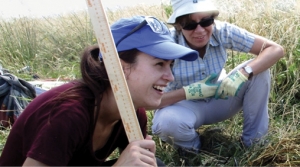Displaying items by tag: Postgraduate research
Nurse trees give saplands a headstart
Stevie Waring has been looking into the benefits of nurse trees in wetlands restoration at Wairio.
Swamps are a category of wetland that are dominated by flood-tolerant trees, which thrive in soils that are nutrient-rich, but occasionally boggy or flooded.
Historically, New Zealand’s swamps were dominated by large podocarp trees,especially kahikatea andtotara, but these were targeted as valuable timber throughout the 19th century. Thereafter, land conversions for urban expansion and agriculture
continued to degrade swamps. A primary goal of wetland restoration is to revegetate sites with native trees.
However, up to 70 per cent of sapling trees can die within the first year of planting. The death of trees increases the financial costs of wetland restoration while reducing the benefits to nature and the morale of project participants. Put simply, dead trees reduce the feasibility of restoration of wetland swamps.
Nearby plants can affect the earlier years of a sapling’s life. For example, highly competitive perennial grasses can shade and outcompete the saplings for light and soil resources. On the other
hand, having neighbours may benefit the sapling.
In exchange for sugars made by the plant in photosynthesis, AMF provide the plant with soil nutrients. Because sapling establishment is influenced by nurse trees over such a wide range of site conditions, nurse effects may be particularly important for trees.
Little is known about how nurse trees affect establishing saplings in wetland restoration. Can strategically planting saplings near nurse trees increase their survival and growth rates? Or are other
site factors such as soil moisture more important for sapling survival?
In my MSc thesis, in the Centre for Biodiversity and Restoration
Ecology at Victoria University, I sought to identify how nurse
trees improve establishment of two podocarp tree species
planted as part of a wetland swamp forest restoration.
In collaboration with Ducks Unlimited and the Department of Conservation, I monitored the survival and growth of kahikatea
(Dacrycarpus dacrydioides) and totara (Podocarpus totara) saplings planted with or without an established nurse trees at the Wairio wetland. The wetland connects a large, ecologically, culturally and recreationally important wetland complex that spans the Wairarapa valley. However, the increased nutrient inputs from livestock and chemical fertilisers and the introduction of pasture plant species have led to a weed-dominated environment.
During restoration, highly competitive perennial grasses can shade and outcompete the newly planted, slowgrowing podocarps. In addition, the complex hydrology of the site leads to species-specific spatial patterns of mortality and growth.
In my studies, I tested whether the presence of a woody nurse tree
(manuka, pittosporum or coprosma) influenced the survival and growth of kahikatea and totara over the critical first year of establishment. I monitored soil moisture, the pH and oxygen status of soils, root-available nutrients, and soil carbon content under saplings planted with and without nurses. I also quantified the abundance of spores of AMF fungi under all saplings.

